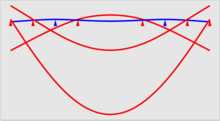Bessel point

The Bessel points are the two symmetrically arranged points of support of a longitudinal beam, where the latter experiences the least possible deformation caused by gravity. The optimal conditions for this minimal deformation can be defined according to different criteria. For the first time, such points were calculated by Friedrich Wilhelm Bessel in connection with the standardization of length measures in the definition of the Prussian system of measurements .
Optimal storage points according to various definitions
If a homogeneous and completely evenly loaded beam with a prismatic cross-section (rod, rod, board) rests on two support points, it is subject to a deformation caused by gravity, which also shortens the beam. For the simplest case of storage on two support points, each with the same distance from the ends of the beam with the total length , the values for the optimal position were calculated according to various criteria:
- Friedrich Wilhelm Bessel determined the position of the supports for the slightest reduction in length of the support in its central area , the neutral plane to . The length criterion was important for Bessel because he was concerned with the storage of measuring rods that were to be compared with the standard of the Prussian length measure .
- In the same context, Bessel also determined the position for the slightest change in length on the surface on which the scale of the measuring rod is engraved. For this case where the end faces of the beam are parallel to each other, he found the value . In honor of George Biddell Airy , who also dealt with the matter, these positions are referred to in the literature as "Airy points".
- A minimum bending over the entire length of the beam is achieved by storage at .
- A zero bend in the middle of the beam requires storage at .
- The minimum mean deflection over the entire length is obtained by storage at . The same result also follows from the assumption of a minimal deformation energy.
- For the lowest maximum bending stress of the girder with the line load , the bending moment at the support points and the amount equal to the bending moment in the middle of the girder (without proof). One receives over
- ,
- ,
- ,
- .
- The result is:
- .
Standards in length measurement technology
"In the standards of length measurement technology, Bessel points are defined as support points that minimize the change in length of a curved ruler in the measuring plane."
literature
- Gert-Jan Nijsse: Linear motions systems; a modular approach for improved straightness performance. Delft University Press, Delft 2001, ISBN 90-407-2187-4 .
Web links
- Optimal positioning (Prof. Peter Will) (PDF; 2.2 MB)
- Optimal storage (Björnstjerne Zindler) (PDF; 10,682 kB)
Individual evidence
- ↑ a b c Gert-Jan Nijsse: Linear motions systems; a modular approach for improved straightness performance. Delft 2001, p. 39f.
- ↑ FW Bessel: Description of the investigations and rules of measure which, in 1835 to 1838, were initiated by the unification of the Prussian length measure. Appendix I. Influence of gravity on the figure of a staff resting on two points of the same height. Berlin 1839, p. 132 ( dig ).
- ↑ FW Bessel, Berlin 1839, p. 135.
- ↑ GB Airy: On the Flexure of a uniform Bar supported by a number of equal Pressures applied at equidistant points, and on the Positions proper for the Applications of these Pressures, in order to prevent any sensitive Alteration of the Length of the Bar by small Flexure. In: Monthly Notices of the Royal Astronomical Society Vol. VI, No.12, January 10, 1845, pp. 143-146 ( dig ).
- ^ Mathematical derivation of the Airy point value .
- ↑ P. Will: Optimal storage of beams.

















